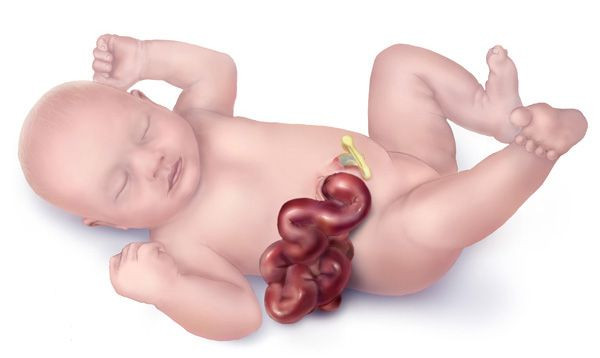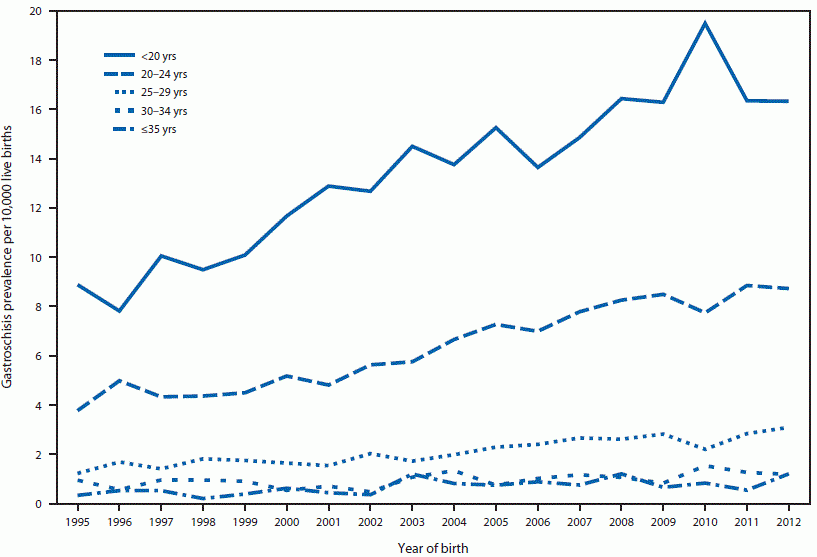Gastroschisis, Birth Defect That Leaves Intestines Sticking Out, On The Rise: CDC

It’s a bizarre birth defect called gastroschisis (gas-troh-skee-sis) that causes a baby’s intestines to protrude outside of thebody — and it’s mysteriously becoming more common.
This Thursday, researchers from the Centers for Disease Control and Prevention (CDC) released a report examining the prevalence of gastroschisis among live births in 14 states from 2006 to 2012. They found it has increased in all maternal age groups since 2005, but especially in babies born to young mothers under the age of 20. Overall, the researchers estimated that 4.9 per 10,000 live births had gastroschisis between 2006 to 2012, a net increase of 30 percent when compared to earlier research on the same states that examined the time period of 1995 to 2005. That period itself saw the number of infants born with the defect nearly double compared to the 1980s.
Put more simply, about one in every 2041 babies in the United States is now believed to come down with gastroschisis, and there’s no simple explanation for why the rate is increasing over time.
“The association between young maternal age and gastroschisis was first reported in the late 1970s, and this risk factor has been documented consistently in subsequent studies,” explained the CDC authors. “However, the increased prevalence of gastroschisis is not because of an increase in teen births, which have declined in recent years, or to a change in the distribution of births to teen mothers, as birth rates have decreased among women of all ages.”
In young mothers, the defect was most common among whites (18.1 per 10,000 live births) and Hispanics (16.1 per 10,000), and least seen in blacks (10.2 per 10,000). Young black mothers, however, experienced a doubling in prevalence between the two time periods studied, the largest increase of any group.

An Unsteady Wall
Gastroschisis is caused by a weakening of the fetus’s abdominal wall (belly) during development. That weakness allows a hole of varying size to emerge, often right next to the belly button, and the fetus’ intestines and/or other internal organs to squeeze outside of the body. While the condition is treatable — with surgery that carefully repacks the infant’s organs inside once they’re delivered — it can have lasting effects on their ability to digest food and properly absorb nutrients, even after repair. And it can occasionally contribute to death, as seen in the case of Meghan Hall, whose son Avery passed away in 2009 due to complications following surgery to treat his gastroschisis.
Hall would go on to help create a nonprofit organization named after her son, Avery’s Angels, to spread awareness about gastroschisis, promote research, and provide support to other afflicted families.
According to the authors, there is some evidence that factors like drug use, poor nutrition and having a young father may be associated with gastroschisis, but much more research needs to be conducted before we can be sure of these connections. In the meantime, the authors are hopeful their findings can galvanize the scientific community to sit up and pay more attention to the condition.
“Gastroschisis is unusual among birth defects in that it disproportionately affects younger mothers, a vulnerable population. The continued increase in age-adjusted prevalence and the pace of the increase suggests that unidentified risk factors might be contributing,” they concluded. “Identification of these risk factors is needed to inform public health interventions and reduce prevalence. Ongoing surveillance is essential to monitor any further increases in prevalence.”
Source: Jones A, Isenburg J. Salemi J, et al. Increasing Prevalence of Gastroschisis — 14 States, 1995–2012. MMWR. 2016.
Published by Medicaldaily.com



























